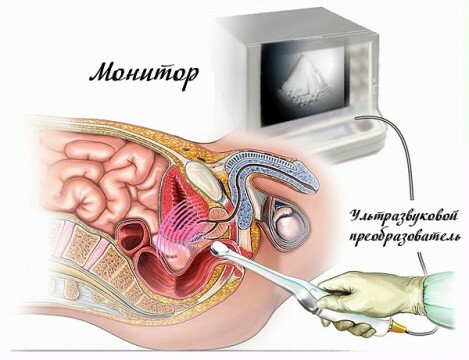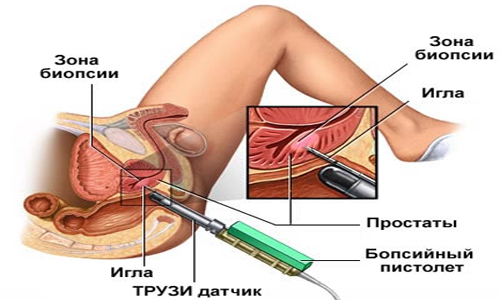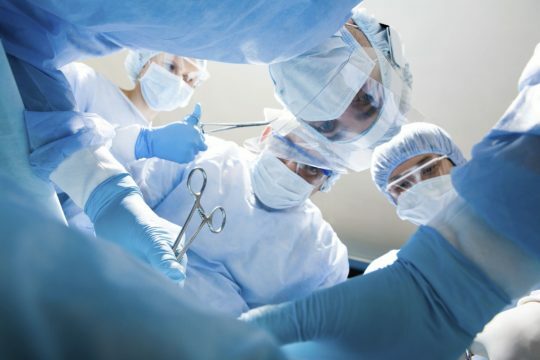Transrectal ultrasound of the prostate is a method of examination using ultrasound. The ultrasonic sensor is inserted into the rectum.
The essence of the research

The basis of the method of the property of ultrasound is reflected from different structures and media with different intensities. These changes are recorded by the computer. Then they are processed, and as a result, a picture is obtained, on which various places are reflected, where ultrasound is absorbed, where it is reflected, and where it is partially absorbed. Decoding the data allows you to read the information received.
The special feature of this ultrasound method is the use of a sensor, which has a special design and relatively small dimensions, providing for its introduction into the rectum. This allows ultrasound to act on the prostate, being directly next to it. Such a decrease in the distance to the prostate gives a clearer and more informative picture than with the usual ultrasound study.
With conventional ultrasound of the prostate through the abdominal wall, the contours of the gland are somewhat blurred due to the thickness of the abdominal wall between the prostate and the sensor. If the patient has excess weight and a dense physique, then the image becomes even more blurred.
Advantages of this method are not only its informativeness, simplicity. Such a study is safe because of the influence of only ultrasonic waves.
This honey is recommended for preventive examination for men who are more than 40 years old, in parallel with the determination of the presence of a specific antigen.
Actually, such examination for violations of urination, problems with potency, pain in the pelvis, with an increase in PSA.
Preparation of
Preparation for the prostatic TRUS is not difficult. However, the appropriateness of all its moments is disputed.
Two days before the study, it is recommended to exclude foods that promote gas generation from the diet. These are fruits, vegetables, carbonated drinks, dairy products( except fermented milk).
Before the examination of the prostate, the intestine must be emptied. You can do this at home with an enema with clean water. It will take 1.5 liters of cool water. You can apply microclysters( Norgulax).You need to do this 2 hours before the study.
For an informative procedure, it is necessary that the bladder is filled. To do this, one hour before a meal you need to drink a liter of not soda water and try not to urinate.
If the test is indicated if there is a micturition, the order of drinking of the fluid varies slightly. Then you need to start drinking water 40 minutes before the test. When there is a urge to urinate, the doctor will make a TRUS.After urinating, the doctor again does the research and assesses how much urine remains in the bladder.
Some doctors who are carrying out the research do not require any preliminary preparation. Unless, with pronounced constipation, a single cleansing enema is recommended. Therefore, all the nuances of preparation are discussed in the preliminary recording for the examination.
Description of the procedure

So, how do the prostate TRUS?The patient lies down on his left side, legs bends at the knees and leads them to his chest. A special condom is placed on the ultrasound sensor. The dimensions of the sensor are small, up to 2 cm in diameter. It is injected into the rectum to a depth of about 6 cm.
If the study is aimed at determining the functionality of the bladder, then the test is repeated after it is emptied. Then, taking into account the size of the shadow from the remaining urine, calculate its volume and judge the pathology.
Decoding of
The decoding of the received information is carried out by the doctor-sonologist. Prostate is normally described in the study protocol as a symmetrical organ, the shape of which is oval or semicircular. Contours are well expressed, clearly, even. The structure is not normally homogeneous. The capsule of the prostate is clearly defined and differs in density from the rest of the gland. The size of the gland is normal as follows:
- length is 24-40 mm;
- thickness of 15-23 mm;
- width 27-43 mm;
- the volume is not more than 200 cubic centimeters.
The study allows to determine the normal peripheral glands and the seminal tubercle. They are hypoechoic. Their dimensions are not more than 2 mm.
When transrectal ultrasound of the prostate can be judged and the status of adjacent to the prostate organs. Thus, varicosity of the hemorrhoidal veins, the state of the vesicle-prostatic plexus is reliably diagnosed. When you increase it, you can talk about venous blood stasis and the violation of outflow of blood from the prostate, which is typical for some of its pathological conditions.
Informative decoding of ultrasound data and in the presence of stones of the bladder, ureters, tumors in these organs. One can also judge the condition of the rectal mucosa.
Documentation
After the examination, the conclusion and protocol of ultrasound of the prostate are given on the hands. They can be accompanied by a disk on which the research is recorded.
The protocol contains data on all the information received during the study. If the prostate TRUS was performed in a patient in a hospital, the protocol is left in the patient's medical history. The protocol contains data on the dimensions of the formations examined, their density, the sharpness and evenness of the edges, their conformity or deviation from the norm. The decoding also describes the amount of urine before and after a certain time after urination.
If pathologies have been found, their location, size, and echogenicity are described in detail. In this case, the protocol contains additional photographs, with which the data on these changes is deciphered.
The conclusion is not a diagnosis! It can only be delivered by a doctor, with the protocol of this study in hand.



